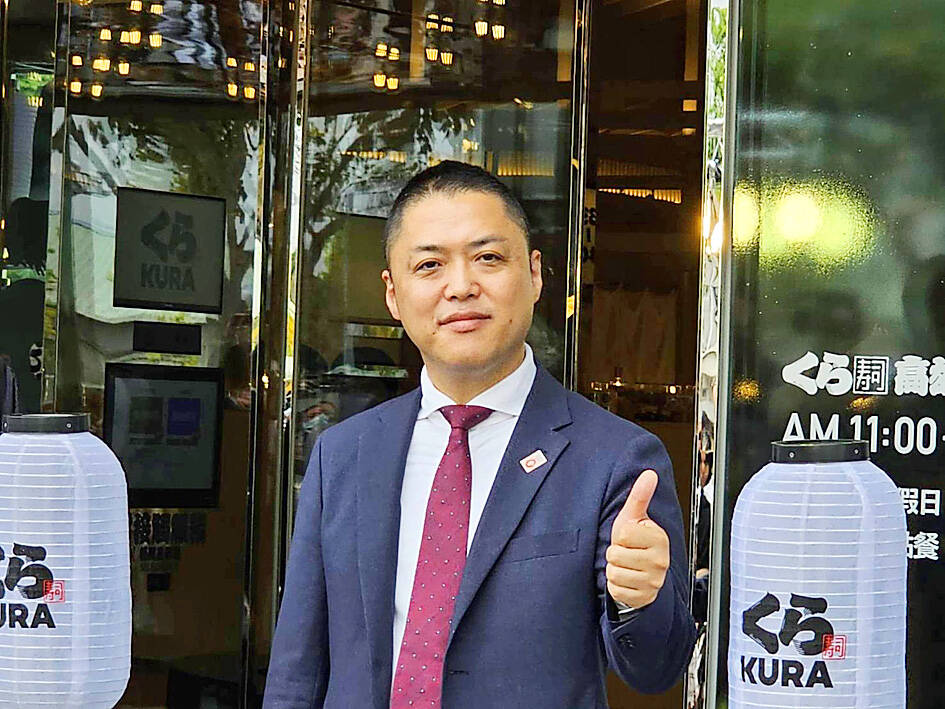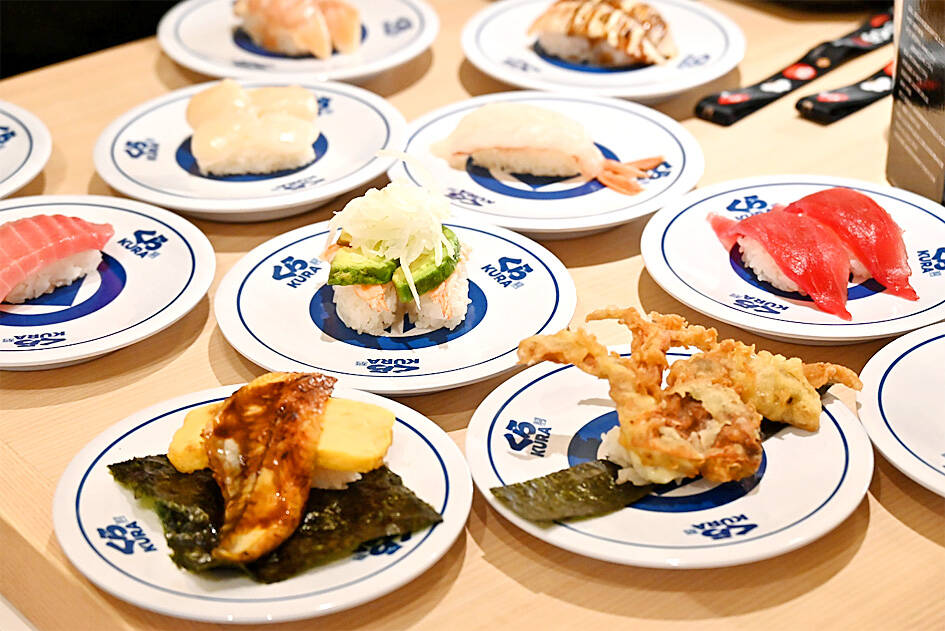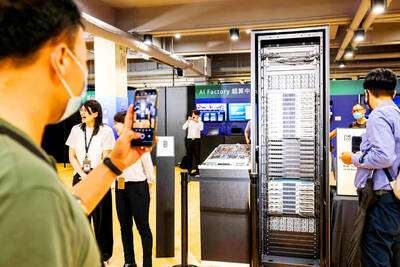Japanese revolving sushi bar restaurant chain Kura Sushi yesterday opened its first overseas flagship restaurant in Kaohsiung. It is also the chain’s 51st outlet in Taiwan.
With an area of 2,000 ping (6,612m2), the flagship restaurant is the largest Kura Sushi outlet in the world, accommodating 288 customers, said Kura Sushi Asia Co (亞洲藏壽司), the company’s Taiwanese subsidiary.
The restaurant designed by Kasiwa Sato combines sightseeing and food, and features 100 Japanese-style lanterns at the front of the outlet, Kura Sushi Asia said.

Photo: CNA
The chain arrived in Taiwan in 2014 with the goal of opening 50 restaurants, a target achieved in January, Kura Sushi Asia chairman Kentaro Nishikawa said.
Kura Sushi has opened four global flagship restaurants in Tokyo and Osaka, and is launching its first overseas flagship outlet in Kaohsiung as it is upbeat about an anticipated boom in the local tourism, and food and beverage industries, the company said.
The conveyor belt sushi chain has 530 restaurants in Japan, 46 in the US, 51 in Taiwan and is set to open its first outlet in Shanghai this year, Nishikawa said.

Photo: Lee Hui-chou, Taipei Times
While many restaurants withdrew from China due to its strict COVID-19 restrictions over the past few years, Kuro Sushi considers it a potential market for business growth and plans to open more stores there, he said.
The firm aims to increase its number of overseas restaurants to 400 by 2030, he added.

LIMITED IMPACT: Investor confidence was likely sustained by its relatively small exposure to the Chinese market, as only less advanced chips are made in Nanjing Taiwan Semiconductor Manufacturing Co (TSMC, 台積電) saw its stock price close steady yesterday in a sign that the loss of the validated end user (VEU) status for its Nanjing, China, fab should have a mild impact on the world’s biggest contract chipmaker financially and technologically. Media reports about the waiver loss sent TSMC down 1.29 percent during the early trading session yesterday, but the stock soon regained strength and ended at NT$1,160, unchanged from Tuesday. Investors’ confidence in TSMC was likely built on its relatively small exposure to the Chinese market, as Chinese customers contributed about 9 percent to TSMC’s revenue last

With this year’s Semicon Taiwan trade show set to kick off on Wednesday, market attention has turned to the mass production of advanced packaging technologies and capacity expansion in Taiwan and the US. With traditional scaling reaching physical limits, heterogeneous integration and packaging technologies have emerged as key solutions. Surging demand for artificial intelligence (AI), high-performance computing (HPC) and high-bandwidth memory (HBM) chips has put technologies such as chip-on-wafer-on-substrate (CoWoS), integrated fan-out (InFO), system on integrated chips (SoIC), 3D IC and fan-out panel-level packaging (FOPLP) at the center of semiconductor innovation, making them a major focus at this year’s trade show, according

DEBUT: The trade show is to feature 17 national pavilions, a new high for the event, including from Canada, Costa Rica, Lithuania, Sweden and Vietnam for the first time The Semicon Taiwan trade show, which opens on Wednesday, is expected to see a new high in the number of exhibitors and visitors from around the world, said its organizer, SEMI, which has described the annual event as the “Olympics of the semiconductor industry.” SEMI, which represents companies in the electronics manufacturing and design supply chain, and touts the annual exhibition as the most influential semiconductor trade show in the world, said more than 1,200 enterprises from 56 countries are to showcase their innovations across more than 4,100 booths, and that the event could attract 100,000 visitors. This year’s event features 17

Hon Hai Precision Industry Co (鴻海精密), which assembles servers for Nvidia Corp, yesterday said that revenue last month rose 10.61 percent year-on-year, driven by strong growth in cloud and networking products amid continued front-loading orders for artificial intelligence (AI) server racks. Consolidated revenue expanded to NT$606.51 billion (US$19.81 billion) last month from NT$548.31 billion a year earlier, marking the highest ever in August, the company said in a statement. On a monthly basis, revenue was down 1.2 percent from NT$613.86 billion. Hon Hai, which is also a major iPhone assembler, added that its electronic components division saw significant revenue growth last month, boosted